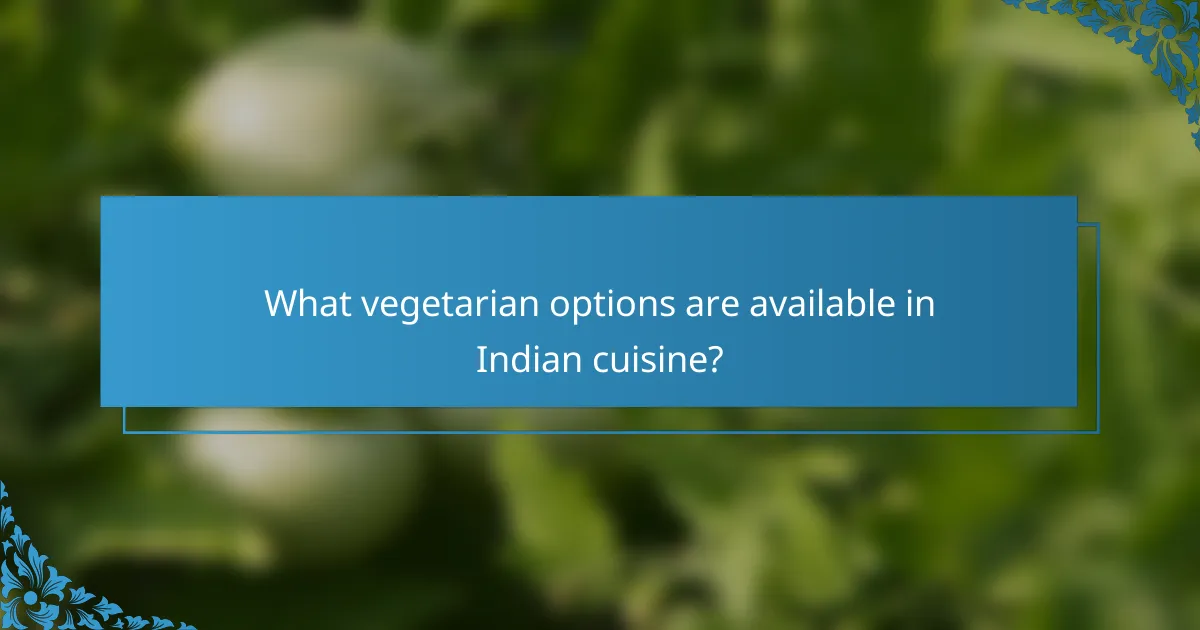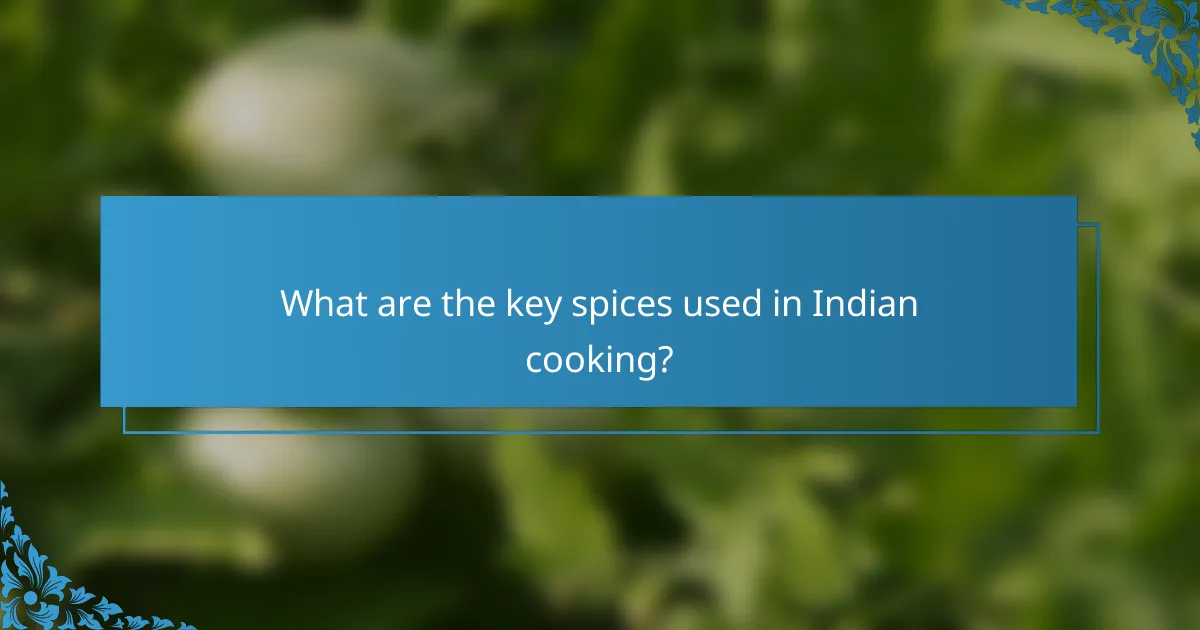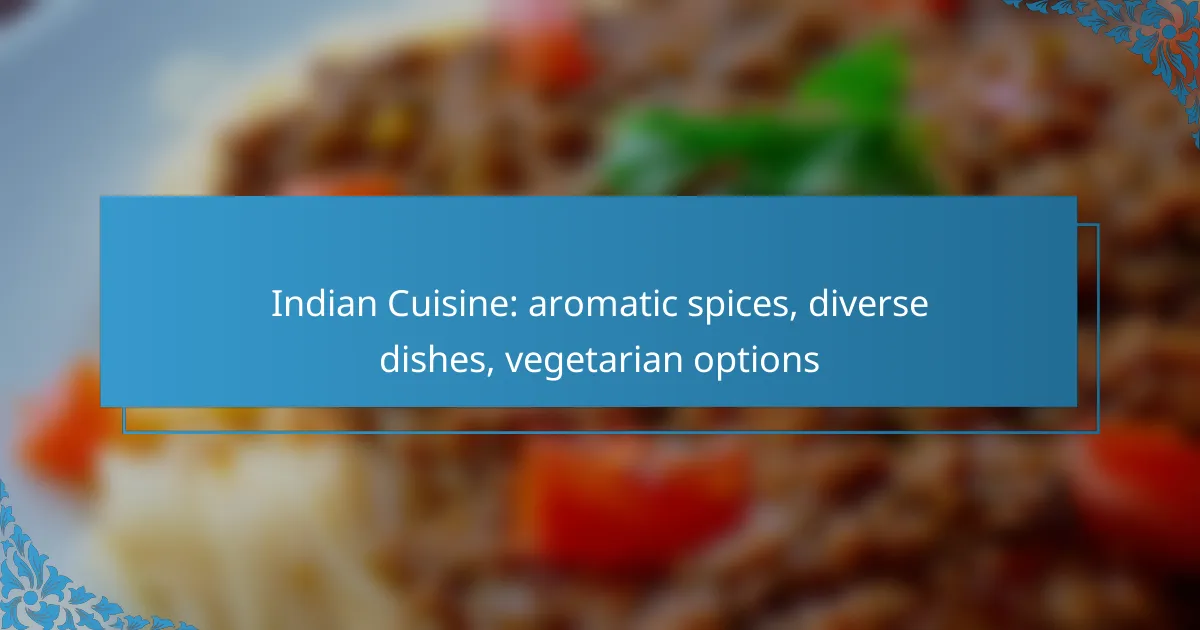Indian cuisine is renowned for its aromatic spices and diverse dishes, creating a vibrant tapestry of flavors that appeal to a wide range of palates. With a plethora of vegetarian options, it serves as a haven for plant-based eaters, showcasing the richness of ingredients and culinary traditions. From the comforting warmth of biryani to the savory delight of palak paneer, each dish offers a unique taste experience that reflects the cultural heritage of India.

What are popular Indian dishes in Los Angeles?
Los Angeles boasts a vibrant Indian food scene, featuring a variety of popular dishes that highlight the rich flavors and aromas of Indian cuisine. Some of the most sought-after dishes include biryani, butter chicken, palak paneer, dosa, and chaat, each offering a unique taste experience.
Biryani
Biryani is a fragrant rice dish that combines basmati rice with marinated meat or vegetables, along with a blend of spices. In Los Angeles, you can find various regional styles, such as Hyderabadi and Lucknowi, each with its own distinct flavor profile. When ordering biryani, consider the spice level and whether you prefer chicken, lamb, or a vegetarian option.
Many restaurants serve biryani with raita, a cooling yogurt sauce, which complements the dish’s heat. It’s often a good idea to share biryani, as portions can be generous, making it a perfect choice for group dining.
Butter Chicken
Butter chicken, or murgh makhani, is a creamy tomato-based curry that features tender chicken pieces marinated in spices and yogurt. This dish is particularly popular in Los Angeles due to its rich flavor and mild spice level, making it accessible for those new to Indian cuisine. It pairs well with naan or rice, allowing you to savor the sauce.
When ordering butter chicken, consider asking for extra spice if you enjoy a bit of heat. Many restaurants offer variations, including vegetarian options made with paneer or tofu, catering to diverse dietary preferences.
Palak Paneer
Palak paneer is a vegetarian dish made with spinach and paneer cheese, cooked in a spiced gravy. This dish is not only flavorful but also nutritious, making it a popular choice among health-conscious diners in Los Angeles. The creamy texture of the spinach sauce complements the paneer, creating a satisfying meal.
To enhance your palak paneer experience, try pairing it with garlic naan or jeera rice. Many Indian restaurants offer this dish as part of a thali, allowing you to sample multiple vegetarian options in one meal.
Dosa
Dosa is a thin, crispy crepe made from fermented rice and lentil batter, often served with a variety of chutneys and sambar, a lentil-based vegetable stew. In Los Angeles, dosas can be found in various styles, including plain, masala (stuffed with spiced potatoes), and even cheese-filled versions. This dish is a popular choice for breakfast or as a snack.
When ordering dosa, consider trying a combination platter to sample different chutneys and fillings. Dosas are typically gluten-free and can be a great option for those with dietary restrictions.
Chaat
Chaat refers to a variety of savory snacks that are typically served at roadside stalls in India. In Los Angeles, popular chaat items include pani puri, bhel puri, and aloo tikki chaat. These dishes are characterized by their bold flavors, combining sweet, tangy, and spicy elements in every bite.
Chaat is often enjoyed as a starter or snack, and it’s best to eat it fresh for the most authentic experience. Many restaurants offer chaat as part of a larger menu, making it easy to sample multiple varieties during your visit.

How to choose the best Indian restaurant in Los Angeles?
To choose the best Indian restaurant in Los Angeles, consider factors such as online reviews, personal recommendations, and the authenticity of the cuisine. These elements will help you identify a restaurant that offers a genuine and satisfying dining experience.
Check online reviews
Online reviews provide valuable insights into the dining experience at various Indian restaurants. Look for platforms like Yelp, Google Reviews, or TripAdvisor, where you can find ratings and detailed comments from previous diners.
Pay attention to the consistency of reviews regarding food quality, service, and ambiance. A restaurant with a high number of positive reviews is often a good indicator of a reliable choice.
Ask for recommendations
Personal recommendations can lead you to hidden gems in the Indian dining scene. Ask friends, family, or colleagues who enjoy Indian cuisine for their favorite spots.
Consider joining local food groups on social media where members share their experiences and suggestions for Indian restaurants in Los Angeles. This can provide you with a diverse range of options.
Look for authentic cuisine
Authenticity is key when selecting an Indian restaurant. Look for establishments that offer traditional dishes and use genuine spices and ingredients. Menus featuring regional specialties can be a good sign of authenticity.
Check if the restaurant has chefs with a background in Indian cooking or if they source ingredients from reputable suppliers. Authentic restaurants often have a diverse menu that caters to various dietary preferences, including vegetarian and vegan options.

What vegetarian options are available in Indian cuisine?
Indian cuisine offers a rich variety of vegetarian options, making it a paradise for plant-based eaters. Dishes are often characterized by their use of aromatic spices, diverse ingredients, and vibrant flavors that cater to different palates.
Paneer Tikka
Paneer Tikka is a popular vegetarian dish made from marinated cubes of paneer, which is a type of Indian cottage cheese. The paneer is typically marinated in yogurt and spices, then grilled or baked until charred and smoky.
This dish is often served with mint chutney and can be enjoyed as an appetizer or a main course. For a complete meal, pair it with naan or rice.
Chana Masala
Chana Masala is a hearty and flavorful dish made from chickpeas cooked in a spicy tomato-based sauce. It is rich in protein and fiber, making it a nutritious option for vegetarians.
This dish is commonly served with rice or flatbreads like roti and is a staple in many Indian households. Adjust the spice level to your preference by varying the amount of green chilies used in the recipe.
Aloo Gobi
Aloo Gobi is a classic Indian dish featuring potatoes (aloo) and cauliflower (gobi) cooked with spices such as turmeric, cumin, and coriander. This dish is known for its vibrant yellow color and comforting flavors.
Aloo Gobi can be served as a side dish or as part of a larger meal, often accompanied by rice or flatbreads. It’s a versatile dish that can be easily modified with additional vegetables or spices.
Vegetable Biryani
Vegetable Biryani is a fragrant rice dish cooked with a mix of vegetables and aromatic spices, often layered with saffron or turmeric for added flavor and color. This dish is known for its complex flavors and is a festive favorite.
To prepare Vegetable Biryani, use basmati rice for the best texture and aroma. Serve it with raita (a yogurt-based side) to balance the spices and enhance the meal experience.

What are the key spices used in Indian cooking?
Indian cooking is renowned for its use of aromatic spices that enhance flavor and aroma. Key spices such as cumin, coriander, turmeric, and cardamom are foundational to many dishes, each contributing unique characteristics to the cuisine.
Cumin
Cumin is a staple spice in Indian cooking, known for its warm, earthy flavor. It can be used in whole seed form or ground, and is often added to curries, stews, and spice blends like garam masala.
To maximize its flavor, toast cumin seeds in a dry pan before using them. This enhances their aroma and depth, making them a perfect addition to both vegetarian and meat dishes.
Coriander
Coriander seeds have a citrusy, slightly sweet flavor that complements many Indian dishes. Ground coriander is commonly used in spice mixes and sauces, while fresh coriander leaves, or cilantro, are used as a garnish.
When using coriander seeds, consider crushing them just before use to release their essential oils for a more robust flavor. This spice pairs well with cumin and turmeric in various recipes.
Turmeric
Turmeric is known for its vibrant yellow color and earthy, slightly bitter taste. It is a key ingredient in curry powders and is celebrated for its health benefits, including anti-inflammatory properties.
When cooking with turmeric, be mindful of its staining properties; it can easily discolor surfaces and fabrics. A little goes a long way, so use it sparingly to achieve the desired color and flavor in your dishes.
Cardamom
Cardamom is a fragrant spice that adds a sweet and spicy flavor to both savory and sweet dishes. It is available in whole pods or ground form, with the whole pods offering a more intense flavor when used in cooking.
To use cardamom effectively, crush the pods to release their seeds before adding them to your dish. This spice is often found in chai tea and biryani, enhancing the overall complexity of flavors.

How does Indian cuisine cater to dietary restrictions?
Indian cuisine is highly adaptable, offering a wide variety of dishes that cater to various dietary restrictions, including vegetarian, vegan, and gluten-free options. This diversity allows individuals with specific dietary needs to enjoy flavorful meals while adhering to their preferences or requirements.
Gluten-free options
Many traditional Indian dishes are naturally gluten-free, making it easier for those with gluten sensitivities or celiac disease to find suitable meals. Staples like rice, lentils, and a variety of vegetables form the foundation of numerous recipes, ensuring a rich culinary experience without gluten.
Popular gluten-free dishes include dosa (a rice-based crepe), idli (steamed rice cakes), and various curries made with chickpea flour or lentils. When dining out, it’s essential to confirm that no gluten-containing ingredients, such as wheat-based sauces or bread, are used in the preparation.
For those cooking at home, using gluten-free flours like rice flour, besan (chickpea flour), or millet flour can help create delicious Indian dishes without compromising dietary needs. Always check labels for cross-contamination and ensure that spices and packaged ingredients are certified gluten-free.
